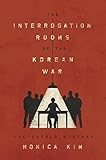The Interrogation Rooms of the Korean War : The Untold History / Monica Kim.
Material type: TextPublisher: Princeton, NJ : Princeton University Press, [2019]Copyright date: ©2019Description: 1 online resource (452 p.)Content type:
TextPublisher: Princeton, NJ : Princeton University Press, [2019]Copyright date: ©2019Description: 1 online resource (452 p.)Content type: - 9780691166223
- 9780691185040
- HISTORY / Military / Korean War
- 38th parallel
- American prisoners of war
- Cold War
- Custodian Force of India
- Francis Dodd
- Japanese American internment camps
- Koje Island
- Korean Communists
- Korean War
- Korean peninsula
- Korean youth
- POW camp
- POW camps
- POW
- Psychological Strategy Board
- UNC
- US Counterintelligence Corps
- US military
- US occupation
- United Nations Command
- World War II
- brainwashing
- decolonization
- diplomacy
- enemy alien
- governance
- intelligence
- international humanitarian law
- interrogation room
- interrogation rooms
- interrogation
- interrogator
- interrogators
- kidnapping
- language
- military conflict
- military occupation
- modern warfare
- nation-state
- neutral explanation rooms
- neutrality
- political recognition
- political strategy
- prisoner of war
- prisoners of war
- repatriation
- rightists
- sovereignty
- thirty-eighth parallel
- warfare
- 951.90424 23
- online - DeGruyter
- Issued also in print.
| Item type | Current library | Call number | URL | Status | Notes | Barcode | |
|---|---|---|---|---|---|---|---|
 eBook
eBook
|
Biblioteca "Angelicum" Pont. Univ. S.Tommaso d'Aquino Nuvola online | online - DeGruyter (Browse shelf(Opens below)) | Online access | Not for loan (Accesso limitato) | Accesso per gli utenti autorizzati / Access for authorized users | (dgr)9780691185040 |
Browsing Biblioteca "Angelicum" Pont. Univ. S.Tommaso d'Aquino shelves, Shelving location: Nuvola online Close shelf browser (Hides shelf browser)

|

|

|

|

|

|

|
||
| online - DeGruyter Bankers and Bolsheviks : International Finance and the Russian Revolution / | online - DeGruyter Austerity : When It Works and When It Doesn't / | online - DeGruyter Newton the Alchemist : Science, Enigma, and the Quest for Nature's "Secret Fire" / | online - DeGruyter The Interrogation Rooms of the Korean War : The Untold History / | online - DeGruyter Dark Matter Credit : The Development of Peer-to-Peer Lending and Banking in France / | online - DeGruyter Journalists between Hitler and Adenauer : From Inner Emigration to the Moral Reconstruction of West Germany / | online - DeGruyter The Book of Revelation : A Biography / |
Frontmatter -- Contents -- Note on Language -- Abbreviations -- Introduction. War and Humanity -- Part I. The Elements of War -- 1. Interrogation -- 2. The Prisoner of War -- 3. The Interrogator -- Part II. Humanity Interrogated -- 4 Koje Island: A Mutiny, or Revolution -- 5. Below the 38th Parallel: Between Barbed Wire and Blood -- 6. On the 38th Parallel: The Third Choice -- 7. Above the 38th Parallel: The US Citizen- POW -- Conclusion: The Diaspora of War -- Acknowledgments -- Notes -- Bibliography -- Index
restricted access online access with authorization star
http://purl.org/coar/access_right/c_16ec
A groundbreaking look at how the interrogation rooms of the Korean War set the stage for a new kind of battle-not over land but over human subjectsTraditional histories of the Korean War have long focused on violations of the thirty-eighth parallel, the line drawn by American and Soviet officials in 1945 dividing the Korean peninsula. But The Interrogation Rooms of the Korean War presents an entirely new narrative, shifting the perspective from the boundaries of the battlefield to inside the interrogation room. Upending conventional notions of what we think of as geographies of military conflict, Monica Kim demonstrates how the Korean War evolved from a fight over territory to one over human interiority and the individual human subject, forging the template for the U.S. wars of intervention that would predominate during the latter half of the twentieth century and beyond.Kim looks at how, during the armistice negotiations, the United States and their allies proposed a new kind of interrogation room: one in which POWs could exercise their "free will" and choose which country they would go to after the ceasefire. The global controversy that erupted exposed how interrogation rooms had become a flashpoint for the struggles between the ambitions of empire and the demands for decolonization, as the aim of interrogation was to produce subjects who attested to a nation's right to govern. The complex web of interrogators and prisoners-Japanese-American interrogators, Indian military personnel, Korean POWs and interrogators, and American POWs-that Kim uncovers contradicts the simple story in U.S. popular memory of "brainwashing" during the Korean War.Bringing together a vast range of sources that track two generations of people moving between three continents, The Interrogation Rooms of the Korean War delves into an essential yet overlooked aspect of modern warfare in the twentieth century.
Issued also in print.
Mode of access: Internet via World Wide Web.
In English.
Description based on online resource; title from PDF title page (publisher's Web site, viewed 29. Jul 2021)


